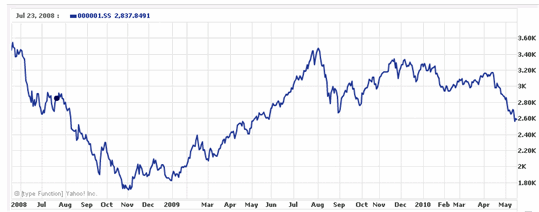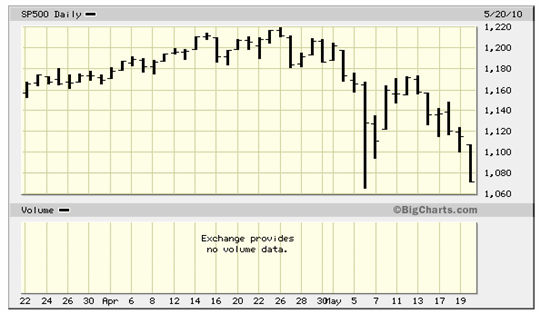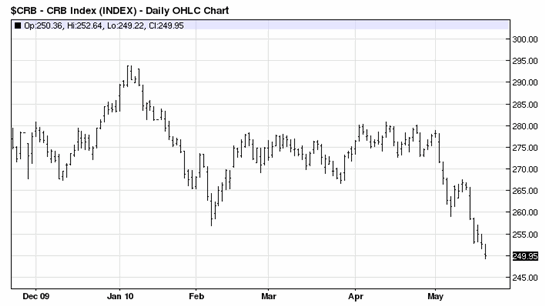Deficits To Go Galactic, Sell in May and Run Away . . . Fast
Stock-Markets / Financial Markets 2010 May 22, 2010 - 02:13 PM GMTBy: Gary_North
 There is an old phrase regarding stock market investing: "Sell in May and go away." Recent markets have reinforced that saying.
There is an old phrase regarding stock market investing: "Sell in May and go away." Recent markets have reinforced that saying.
Stock markets all over the world are falling. The first market to begin falling was China's. It peaked in early August of 2009. It struggled back, though not to its August peak, but is now falling. The decline is accelerating. It is down by about 25% in 2010.

The American stock market has been hit hard this month. So have European stock markets. They are plummeting.

Commodity prices are falling – not like a stone, but falling. The peak was in the first week of January.

Consumer prices are falling, just barely, and only if you accept the CPI: down 0.1% in April. If you use the Median CPI, as I do, it was unchanged over the previous two months: flat. More important, the rate of price increases, year to year, is decelerating. In November and December, the Median CPI was up 1.2%. In January, it was up 1%. In April, it was up 0.5%. The figures are here.
Gold is down. Silver is down. Oil is down. The euro is down. Mortgage rates are down. Mortgage applications are down.
The main thing that is up is mortgage payment skipping. At least 10% of American households missed a monthly mortgage payment during the first three months of 2010. This is an all-time high in the post-World War II era. The rate was 9.1% in the first quarter of 2009. It rose to 9.5% in the final quarter. The trend is ominous. Americans will stop making payments on every other category of debt before they skip a mortgage payment. The fact that they are skipping mortgage payments indicates that they are in very tight straits.
What is happening? This is not consistent with Keynesianism. Keynesians did not predict the 2008–9 recession, either. The other schools of economic thought that also did not predict the recession cannot explain why these signs of a secondary recession are taking place today, despite a huge increase in both the monetary base and government deficits.
One school of opinion did predict the 2008–9 recession: the Austrian School. Can Austrian theory explain this new situation?
THE BUSINESS CYCLE
The Austrian theory of the business cycle, developed by Ludwig von Mises in 1912, teaches that when central banks inflate, in order to hold down interest rates, this creates false price signals. Specifically, it creates false signals regarding the price and availability of capital. This in turn leads entrepreneurs to borrow money and invest in new projects. When the central bank ceases to inflate, these projects are revealed as unprofitable ventures.
Around the world in late 2008, central banks inflated massively to save the financial structure. They bought government bonds. They loaned money to commercial banks. The Federal Reserve swapped assets with the largest banks, giving them T-bills at face value and taking back toxic assets without any market for them. This was like trading the family silver for crushed beer cans. Congress said nothing. Keynesian economists cheered Bernanke's brilliance.
The collapse of the largest banks was delayed. Their survival enabled them to swallow the busted giants like Wachovia. The central bank bought bad assets and time. The assets are still bad, and the clock is ticking.
Had commercial banks lent out the money they were legally allowed to lend, we would be in hyperinflation today. I define hyperinflation as price increases above 30% per annum. The FED doubled its balance sheet and therefore monetary base.
Commercial banks are legally allowed to double their loans, which would double the money supply. The bankers are so terrified of this economy that they have refused to lend. They have run up excess reserves at the FED of $1.2 trillion, thereby offsetting the FED's comparable run-up of the monetary base.
The deficits of all major nations are massive today. The governments are borrowing money to bail out their economies. But the money is being wasted. It is going for politically acceptable boondoggles and payoffs to special interests. It is not funding projects to meet consumer demand.
These policies of monetary inflation, government debt, and political boondoggles are the essence of Keynesianism. They are known politically as kick the can. The essence of Keynesianism is for governments to borrow massively in order to solve the problems created by previous less massive borrowing by governments, entrepreneurs, and consumers.
The economic recovery is based on the idea that it is productive to substitute government borrowing and spending for private borrowing and spending. The Keynesian believes that the private sector will not borrow until entrepreneurs perceive future customer demand. Keynesians believe that politicians are capable of restoring economic growth by spending money on pet projects.
Whenever entrepreneurs who have their own money or borrowed money on the line conclude that the likelihood of losing it is just too high until production goods and labor get cheaper, Keynesians call on government to borrow, central banks to inflate, and consumers to spend, spend, spend. Why? In order to keep production goods from getting cheaper and labor from get cheaper. Why? Because when production goods get cheaper, corporate donations to the opposition party's PACs increase. When labor gets cheaper, voters vote for the opposition party.
All over the world, politicians are using borrowed money and newly created money to keep the prices of production goods from falling. This worked until early January. It is no longer working. Commodity prices are falling. They will continue to fall. Why? Because commercial bankers are not lending, and businesses are not borrowing. The American labor market is still crippled. With unemployment in the 10% range, delayed mortgage payments are in the 10% range. Will wonders never cease?
JIM VS. JIM
Jim Rogers is bullish on China. Jim Chanos is bearish on China's real estate market. Jim Rogers is bullish on commodities. Jim Chanos has sold short companies that export to China's real estate sector.
Jim Rogers says he is no market timer. Jim Chanos is a supreme market timer, for he sells short. He sold Enron short.
I'm with Chanos. That's because I came to the same conclusion regarding China's real estate bubble before Chanos announced his position. Chanos agrees with me, so of course I'm with Chanos.
China's economy is the ultimate schizophrenic monster. It has free choice for individuals to buy and sell. People can move. It has a Communist elite, which is committed to maintaining power, no matter what. It has a central bank that is under the thumb of the central government, which inflates constantly. It has corruption on a massive scale at the local political level. It has a traditional family structure, despite Marxism/Maoism, whose members see the preservation of family capital as a central goal.
This has combined to create the mother of all real estate bubbles. Tiny condos in Beijing and Shanghai sell at $400 per square foot. Who is buying these condos? Newlyweds whose combined income is under $6,000 a year. How is this possible? Because newly rich parents and grandparents are putting up the money. These investments are senseless as third-party loans, but inside the families, these wealth transfers are considered rational.
All over China, there has been massive building of apartments and condos. The central bank lends money to banks, which in turn lend to politically favored developers at low rates. The municipal authorities sell land at high prices to developers.
This has created a bubble. This bubble is consistent with Austrian economic theory. Central bank inflation leads to commercial bank lending to fund uneconomic projects. Low interest rates lure in entrepreneurs. They invest capital.
This drives up the costs of construction. When the central bank finally ceases to expand the monetary base, the boom will turn into a bust. The fact that condo buyers do not borrow money from local banks is economically irrelevant. What matters is that developers borrow to build them. The newlyweds borrow from their families.
Investors are buying multiple condos. They then hold them off the market, on the assumption that a new condo will appreciate faster. So, these condos' pricing is not based on their ability to produce a stream of long-term revenue. They are purchased as pure speculations. The mania is in full force. This is the classic mark of the final stage of a real estate bubble. Those caught up in it cannot see that it cannot go on. They think this is the last train out. They borrow from their relatives to buy a ticket.
Chanos has seen that this cannot go on much longer.
RECOVERY OR ILLUSION?
The decline in commodity prices since January is consistent with the re-trenching of entrepreneurs. They are convinced that prices of final goods will hit a brick wall next year. They do not trust the economy. They see consumer prices going flat. They see that they will be trapped if they expand their operations.
The recovery in manufacturing in the United States is real. The producers are expanding output. But the fall in commodities indicates that this optimism is not worldwide. Commodity prices should be rising, as manufacturers around the world bid up prices in an attempt to secure greater quantities in order to convert them into final products. The opposite is happening. Commodity prices are falling.
Investors must decide. Should they buy commodities, as Jim Rogers recommends, or should they short them? Chanos has shorted some of them – those related to China's real estate boom.
I do not trust this recovery. That is why I did not recommend buying commodities in 2009. I think that until commercial bankers regain their confidence and begin lending, this recovery will hit a brick wall. This will be a wall of resistance by final buyers. I look at what has happened to consumer prices, and I conclude that my skepticism a year ago was correct.
There can be mass inflation. It is assured when commercial bankers pull their excess reserves out of the FED and begin to lend. The doubled monetary base will become a doubled M1 and a rising money multiplier. The FED in this sense has created a time bomb for the economy. It is still ticking, because of the pessimism of commercial bankers. They are not lending, especially to small businesses, which historically do most of the new hiring.
The decline in commodity prices is consistent with the decline of the rate of increase in the price indexes. Consumer prices have decelerated. The CPI and Median CPI are flat. The increase in commodity prices that took place in 2009 in expectation of a V-shaped recovery ended in early January. When you see this for the year, you can see when optimism collapsed.
The entrepreneurs who make their money by forecasting prices, and therefore final demand for the goods produced by commodities, decided in January that this recovery could not be trusted to provide increasing demand. They began selling commodity futures. At the margin, they decided that it was wiser to be short than long.
Maybe they were wrong. Maybe the worldwide recovery will continue. But if it does, it will be marked by low or no price inflation. It is not that the fall in commodity prices will create falling consumer prices. It is that falling commodity prices fell because entrepreneurs saw low or no price inflation coming in 2010. They quite bidding to buy.
CONCLUSION
The expansion of central bank money, used to buy bad assets and save companies that should have been allowed to fail, was a frantic response to a looming breakdown of large New York banks and financial institutions. The capital markets were vetoing central bank policies, and the central bank's bureaucrats fought back with fiat money.
The toxic debt has replaced Treasury debt on the FED's balance sheet. With a $1.5 trillion Federal deficit scheduled for this year, the FED has been content to stop inflating and let the private sector fund the deficit. This money could have gone into the private sector. That it did not is an indicator of the fragility of the recovery.
The world's capital markets are vetoing the central bankers' policies and the politicians' policies. This may change. Confidence may return. But the fiasco that is the Greek government has triggered the response of frantic and terrified politicians in the north of Europe. They did the Keynesian thing. They promised a huge bailout. It is clear that they will do it again if required. It will be required.
To call this recovery fragile is facing facts. This week, fear is dominant. What the central bankers and the politicians can do to restore confidence is not clear. Europe has shot its fiscal wad. Another round will send a message: "Bailouts forever." The same dilemma faces Bernanke.
Politicians play kick the can. Commercial bankers will force Bernanke's hand when they start lending. So far, markets say they won't. The experts are saying this recovery is unlikely to last. They are saying that consumers are tapped out. That is bad news for Keynesians. With tapped-out consumers, the Keynesians must recommend another round of huge deficits. I thought $1.5 trillion was a lot of annual deficit. Apparently, I'm too conservative.
Gary North [send him mail ] is the author of Mises on Money . Visit http://www.garynorth.com . He is also the author of a free 20-volume series, An Economic Commentary on the Bible .
© 2010 Copyright Gary North / LewRockwell.com - All Rights Reserved
Disclaimer: The above is a matter of opinion provided for general information purposes only and is not intended as investment advice. Information and analysis above are derived from sources and utilising methods believed to be reliable, but we cannot accept responsibility for any losses you may incur as a result of this analysis. Individuals should consult with their personal financial advisors.
© 2005-2022 http://www.MarketOracle.co.uk - The Market Oracle is a FREE Daily Financial Markets Analysis & Forecasting online publication.



